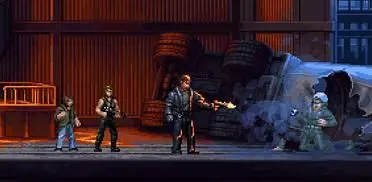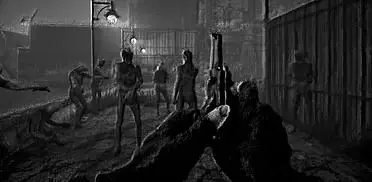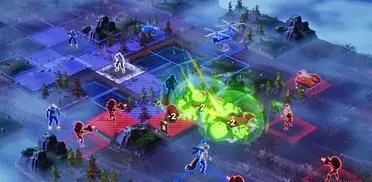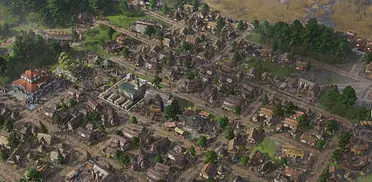Fortunately, it’s different enough to be able to stand alone, at least theoretically. It’s offering something no other game released during that period is, and that’s complex-yet-accessible tactical multiplayer gameplay. That’s what Splash Damage think and, after battling away in the world of the Ark for a few hours, it’s very easy to see how this could be a surprise smash hit.
 |
| Ziggy Marley's career had took a turn for the worse somewhere, it seems |
Quake Wars was better, but there were still elements of it that were oblique at best to many players. It also suffered from large maps with too many dead zones where nothing happened, something Brink won’t have a problem with because the maps are much more streamlined this time out.
It’s closest rival in terms of feel, look and design is naturally Team Fortress 2, with the exaggerated, colourful cartoon look being the most obvious comparison. You can even create a passable Heavy - Medic duo with good teamwork and the right class configuration, but there’s a lot in Brink you won’t find anywhere else.
Like previous Splash Damage games, the gameplay is class-based. This time out there are four specific classes to choose from, the Soldier, the Medic, the Operative and the Engineer. Like most things in the game, this selection is slimmed down from previous titles, so each class takes on abilities that they wouldn’t have done before.
The Soldier, for example, is now the one doling out the ammo, like the Field Ops in Quake Wars used to do. It’s just one of a multitude of small changes veterans will be nodding their head at in appreciation, like Medics reviving people using syringes that now have to be injected by the dying player, so if they’re in a desperate situation not wanting to be revived, they can then choose not to use it, while the Medic gets the XP for at least trying to save them.
Anyway, our hands-on time was hosted in a swanky London hotel, although the journalistic throng was corralled into a basement room away from the public eye. PS3 controllers in hand, we were shown a tutorial video to familiarise us with the game, its concepts and controls. There’ll be plenty of these for new players to view in the game, Splash Damage acutely aware that accessibility will be key to newcomers embracing Brink.
The first map we were shown was typical Splash Damage - layered objectives that required different skills to complete. First, engineers had to bring down a large door barring the way, before everyone had to chip in to allow a vehicle to pass through. After it had reached its destination, the race was on to steal a briefcase full of bio-weapons information and return it to base.
Each individual objective could well be a level in and of itself, but that’s not how Splash Damage does things. Each member of the team is always useful, so there’s never any class bunching going on. There’ll perhaps be a majority of one if an objective is proving difficult to complete, but generally a team will only function well if there’s a good balance of classes in it.
 |
| Damn it, the trains NEVER run on time in this place... |
None of the vast range of unlockable weapons or body types are class-specific, so if you wanted to be a hulking, minigun-wielding Operative, you could be. Likewise you could be fleet-footed soldier, it just depends on what you feel might be useful at the time. Heavy bodies can’t climb as well or even reach certain places at all, while light ones can’t wield the heftier guns, so you can’t be a slim Operative carrying the same minigun, for example.
Choosing a slim-built character is the most effective way of showcasing just why Brink is different to a lot of other shooters, because the increased agility allows you to use the fluid movement system more effectively than a hulking beast. Holding the run key and charging climbable walls will see you leap up, grab the ledge and vault up easily.
Getting to grips with the controls might have stopped us exploring the movement system fully, it’s obvious that this will provide another layer of depth to an already rich experience, with body types making a great difference to just how you’ll approach each level. The second map we were shown involved breaking an important resistance member from a heavily guarded jail complex, allowing all of us, slim and chunky players alike, the chance to perform various important tasks.
Your correspondent, as a minigun-equipped heavy Soldier, was used to plough through the defenders, Medics flitting around behind buffing health and providing vital syringes, while thinly built Operatives provided intelligence on the enemy’s positions and giving the frontline troops’ weapons a damage boost.
For those not guided solely by the urge to kill, the objective wheel - a refined version of the system used in Quake Wars - is a vital tool, helpfully providing a guide to just where everything important is on the map, with both general and class-specific objectives available to select. It means that when you’re lagging behind or feeling a bit lost, you’ll be able to find out exactly where you need or want to go.
You might find, as an Operative, that you can’t get stuck into the fight as you might wish, so just use the wheel to find a hackable command post and you can skip off there, perhaps taking the enemy by surprise and providing both a welcome diversion for your beleaguered soldiers and a boost to the health of the whole team.
 |
| "Hey, Buddy! This is no time for aerobics!" |
Just the question of whether people will pass over more high profile titles to get to it remains. It would be nice to say “Yes! Definitely!” and you can be assured that your correspondent here will be getting stuck in on the day of release, but the average man in the street? Difficult to say. Even with the streamlining, it’s a game with remarkable depth and for some reason that could put people off. Not this writer, though. You’ll find me on the frontlines come May. Perhaps I’ll see you there.
Most Anticipated Feature: Customization seems like it might be worth delving into.




